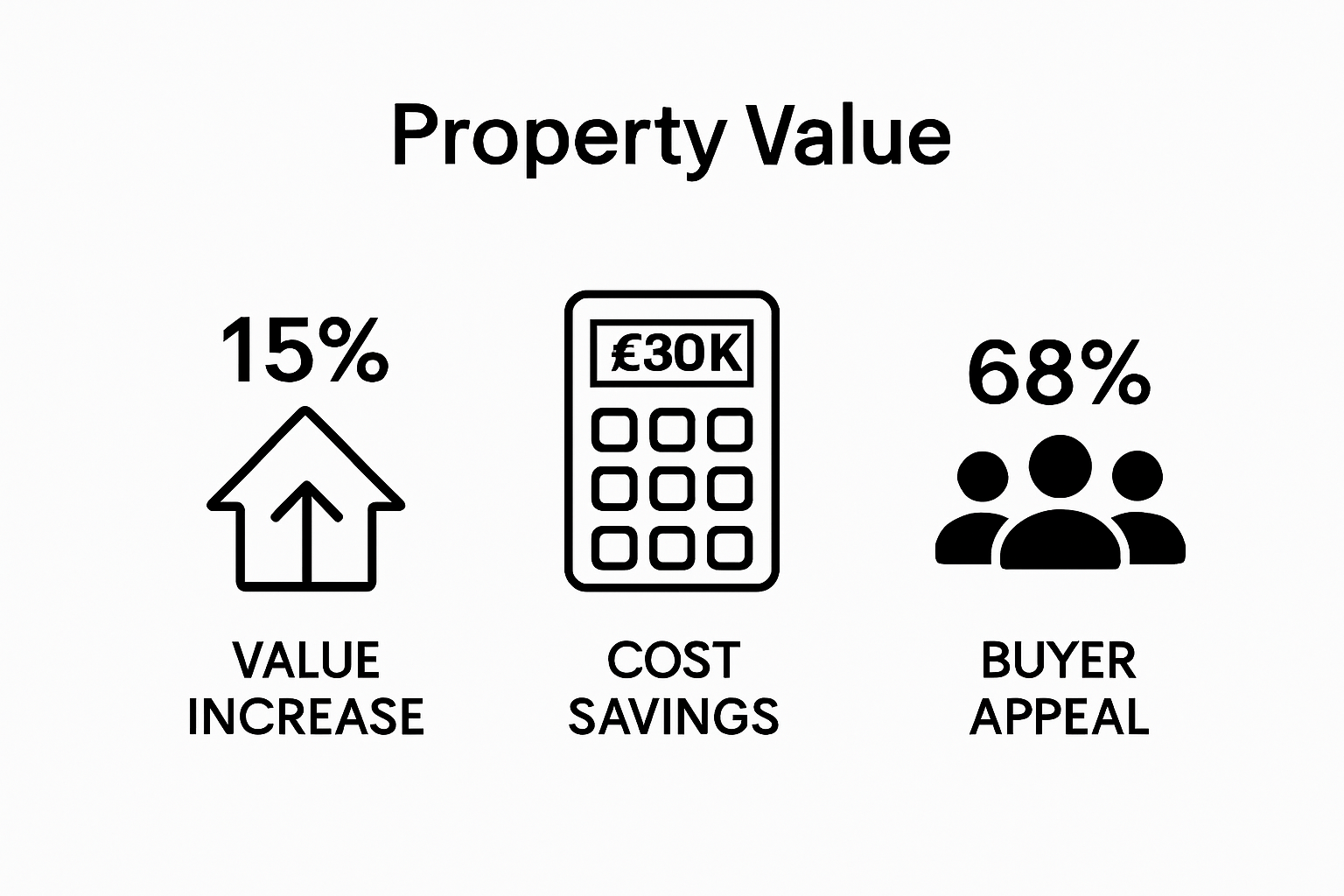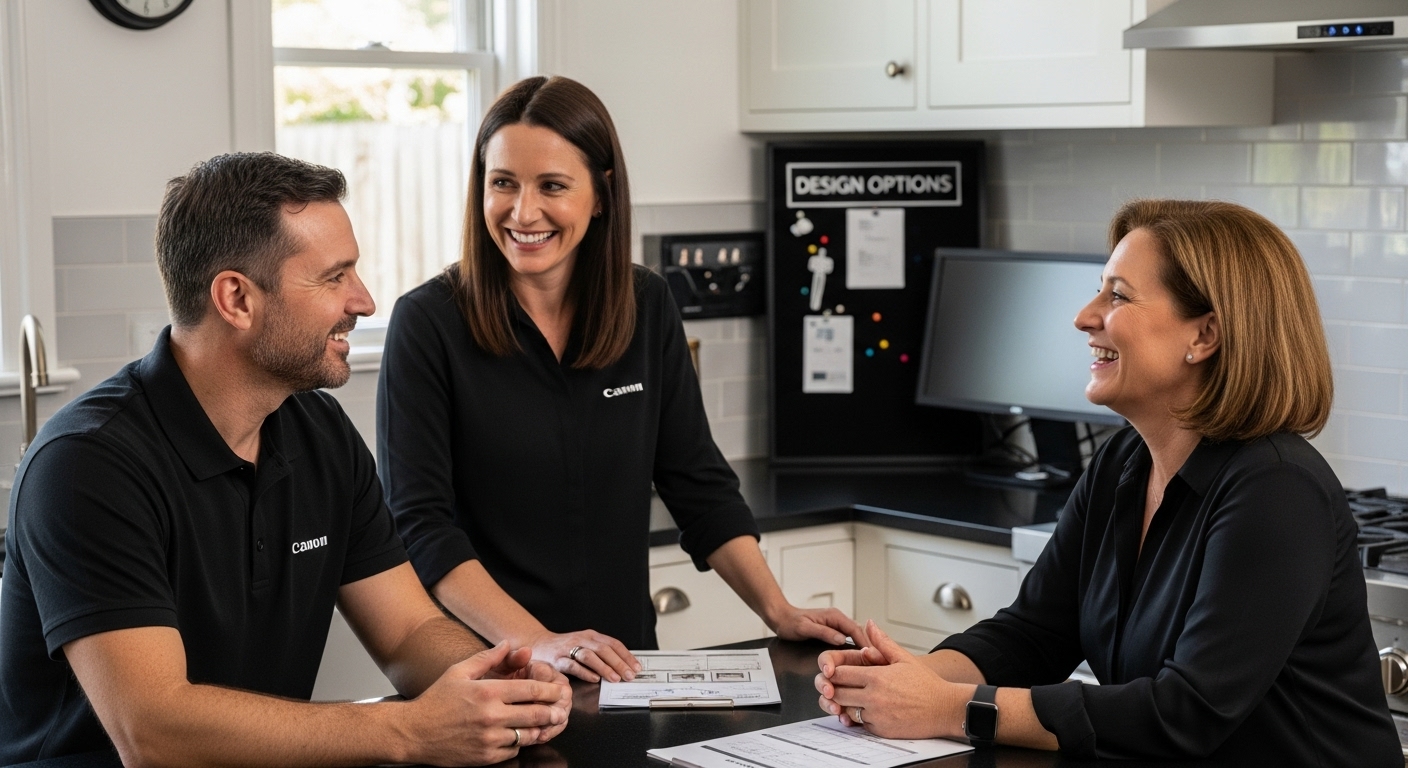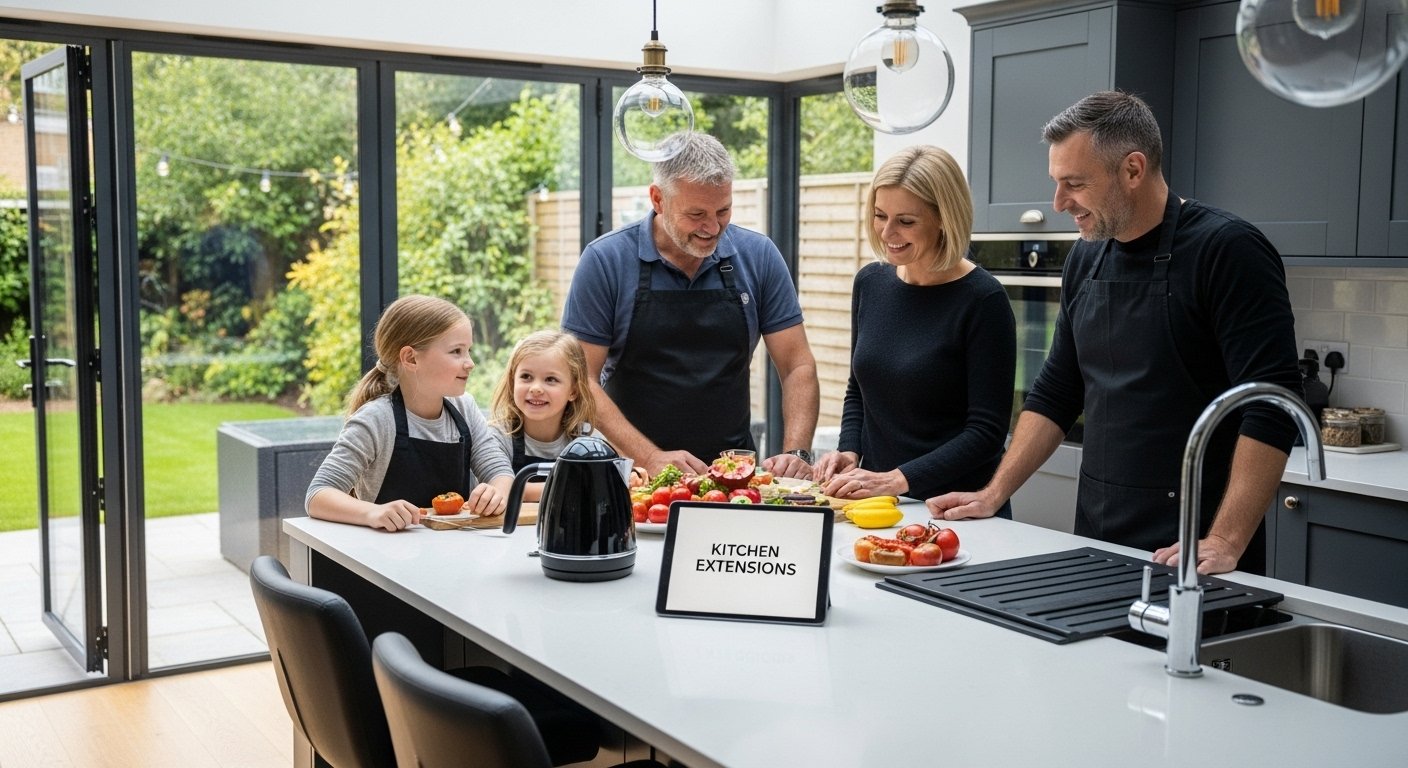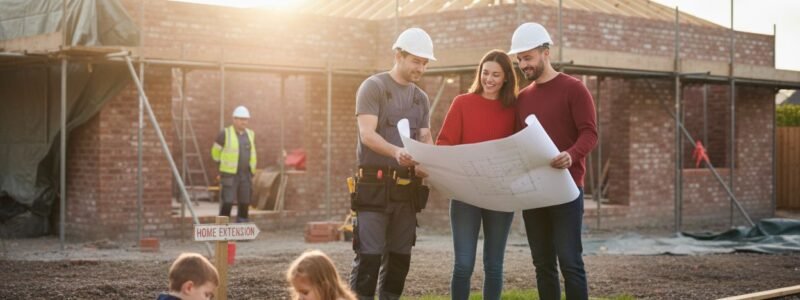Kitchen extensions have become one of the most popular ways to add space and value to UK homes. Some projects can even increase your property’s value by up to 15 percent, according to recent housing surveys. Yet, what might surprise most people is that the true appeal goes far beyond extra room or house prices. The real magic is how a well-designed extension can transform the way families live, connect, and enjoy their own homes every single day.
Table of Contents
- What Is A Kitchen Extension And Its Purpose?
- Why Kitchen Extensions Are Valuable For Homeowners?
- Key Concepts Related To Kitchen Extensions And Design Options
- How Planning Permissions Work For Kitchen Extensions
- Real-World Considerations And Impact Of Kitchen Extensions
Quick Summary
| Takeaway | Explanation |
|---|---|
| Kitchen extensions increase property value significantly. | Expanding your kitchen can boost your home’s market value by 10-15%, making it a wise financial investment. |
| Extensions enhance living space functionality. | They create larger, more versatile areas that support cooking, dining, and social activities in an open-plan fashion. |
| Permitted development rights simplify planning. | Many kitchen extensions can be constructed without full planning permission, streamlining the process for homeowners. |
| Sustainability is a critical design focus. | Incorporating energy-efficient materials and designs can lower utility costs and reduce environmental impact. |
| Professional guidance can ease compliance. | Engaging architects or planning consultants helps navigate the complexities of regulations and improves project outcomes. |
What is a Kitchen Extension and Its Purpose?
A kitchen extension represents a strategic home improvement project designed to transform and expand the culinary and living spaces within a residential property. Unlike traditional renovation work, these extensions go beyond mere cosmetic changes by physically enlarging the kitchen area and creating more functional, versatile living environments.
Understanding Kitchen Extension Fundamentals
Kitchen extensions are architectural modifications that involve extending the existing kitchen space horizontally or vertically to increase square footage and improve overall functionality. Our comprehensive guide on kitchen extensions provides deeper insights into these transformative home improvements.
The primary purposes of a kitchen extension include:
- Creating more spacious cooking and dining areas
- Enhancing natural light and ventilation
- Improving property value and aesthetic appeal
- Generating additional multi-purpose living spaces
According to government planning guidelines, kitchen extensions can typically be constructed under permitted development rights, which means homeowners often do not require full planning permission for moderate improvements.
Design and Functional Considerations
Modern kitchen extensions are not merely about adding space but creating intelligent, adaptable environments that reflect contemporary lifestyle needs. Homeowners increasingly view these extensions as opportunities to design open-plan living areas that seamlessly integrate cooking, dining, and socialising spaces.
Typical kitchen extension designs might include rear extensions, side return additions, or wraparound configurations that dramatically transform the ground floor layout. These projects aim to establish fluid, connected spaces that maximise natural light, improve interior flow, and provide flexible areas for cooking, entertaining, and family interactions.
Below is a comparison table outlining the main types of kitchen extension design configurations, highlighting their distinctive features and suitability for different property layouts.
| Extension Type | Description | Best Suited For |
|---|---|---|
| Rear Extension | Extends outwards at the back of the property | Homes with ample garden space |
| Side Return Extension | Utilises unused space at the side of the house | Terraced or semi-detached houses |
| Wraparound Extension | Combines rear and side to form an L-shaped extension | Maximising ground floor area |
| Double-Storey Extension | Builds vertically as well as horizontally | Gaining more space on two floors |
The purpose extends beyond physical expansion, representing a strategic investment in both living quality and property market value.
A well-executed kitchen extension can significantly enhance a home’s functionality, aesthetic appeal, and potential resale attractiveness.
Why Kitchen Extensions are Valuable for Homeowners?
Kitchen extensions represent far more than a simple home improvement project. They are strategic investments that deliver substantial financial, functional, and lifestyle benefits for homeowners seeking to enhance their living spaces.
Financial and Property Value Enhancement
Understanding the benefits of kitchen extensions reveals significant economic advantages. According to the HomeOwners Alliance, kitchen renovations consistently rank among the most valuable home improvements, potentially increasing property value by up to 10-15%.
Key financial benefits include:
- Immediate increase in property market value
- Potential return on investment during future property sales
- Enhanced attractiveness to potential buyers
- Reduced relocation costs compared to moving to a larger property
Functional and Lifestyle Improvements
Beyond financial considerations, kitchen extensions transform living experiences by creating more adaptable, multifunctional spaces. Modern homeowners increasingly desire open-plan environments that support contemporary lifestyle needs such as simultaneous cooking, socialising, and working.
The functional advantages extend to:
- Creating larger, more ergonomic cooking spaces
- Generating additional natural light
- Improving home layout and interior flow
- Supporting multigenerational living arrangements
Quality of Life and Personal Wellbeing
Kitchen extensions are not merely architectural modifications but investments in personal comfort and wellbeing. By designing spaces that reflect individual lifestyle requirements, homeowners can create environments that promote family interactions, support home-based activities, and enhance overall living satisfaction.
The Energy Saving Trust emphasises that extensions also present opportunities for improving home energy efficiency, potentially reducing long-term utility expenses and contributing to environmental sustainability through strategic design and material choices.

Key Concepts Related to Kitchen Extensions and Design Options
Kitchen extensions represent complex architectural interventions that require comprehensive understanding of design principles, spatial planning, and regulatory considerations. Successful implementations demand strategic thinking and nuanced approach to home improvement.
Architectural Design Configurations
Exploring modern extension style examples reveals multiple design approaches tailored to different property types and homeowner preferences. Extension configurations typically include:
- Rear extensions creating direct garden connections
- Side return additions maximising narrow plot spaces
- Wraparound designs transforming ground floor layouts
- Double-storey extensions providing substantial additional space
According to government planning guidelines, each configuration carries specific regulatory requirements and potential restrictions based on property characteristics.
Spatial Planning and Functional Considerations
Effective kitchen extensions transcend mere physical expansion, focusing on creating intelligent, adaptable living environments. Successful designs integrate multiple functional considerations:
- Optimising natural light penetration
- Ensuring seamless interior flow
The National Design Guide emphasises creating spaces that support contemporary lifestyle needs, promoting flexibility, accessibility, and sustainable living principles.
Material Selection and Technical Specifications
Comprehensive kitchen extension design involves meticulous material selection and technical planning. Homeowners must consider structural integrity, thermal performance, aesthetic harmony, and long-term durability.
Key technical considerations include:
- Structural load-bearing requirements
- Thermal insulation standards
- Acoustic performance
- Energy efficiency ratings
- Compatibility with existing architectural styles
Successful kitchen extensions represent sophisticated architectural interventions that balance aesthetic aspirations, functional requirements, and regulatory compliance, transforming living spaces through intelligent design strategies.

How Planning Permissions Work for Kitchen Extensions
Planning permissions represent a critical regulatory framework governing home improvement projects, ensuring that residential modifications align with local architectural standards, community aesthetics, and sustainable development principles.
Understanding Permitted Development Rights
Our comprehensive guide to house extension approval highlights the nuanced landscape of planning regulations. According to government planning guidelines, many kitchen extensions can be undertaken under Permitted Development Rights, which allow homeowners to expand their properties without formal planning applications.
Key characteristics of Permitted Development include:
- Maximum rear extension depth of 3-4 metres for detached houses
- Maximum height restrictions of 4 metres
- Limitations on total ground coverage
- Requirement for materials matching existing property
Scenarios Requiring Full Planning Permission
Certain circumstances mandate comprehensive planning permission, including:
- Extensions in conservation areas
- Modifications to listed buildings
- Proposals exceeding standard dimensional limitations
- Projects impacting neighbouring properties’ rights
- Significant alterations to property’s external appearance
Application Process and Considerations
The planning permission process involves detailed evaluation of proposed kitchen extensions. Local planning authorities assess proposals based on multiple criteria:
- Compliance with local development frameworks
- Impact on street scene and neighbourhood character
- Potential effects on neighbouring properties
- Environmental sustainability considerations
- Alignment with national and regional architectural guidelines
Homeowners must submit detailed architectural drawings, site plans, and contextual information demonstrating how the proposed kitchen extension integrates harmoniously with existing structures and community environments. Professional guidance from architects or planning consultants can significantly streamline this complex regulatory navigation.
The following table summarises circumstances under which permitted development rights apply to kitchen extensions versus when full planning permission is required, helping to clarify the distinction for homeowners.
| Scenario | Permitted Development | Full Planning Permission Required |
|---|---|---|
| Rear extension within size limits | Yes | No |
| Exceeding standard size/height limits | No | Yes |
| Located in a conservation area | No | Yes |
| Modifications to a listed building | No | Yes |
| Materials match existing property | Yes | No |
| Significant changes to street appearance | No | Yes |
Real-world Considerations and Impact of Kitchen Extensions
Kitchen extensions represent complex home improvement projects with multifaceted implications beyond architectural modifications. Understanding their broader real-world impact requires comprehensive analysis of financial, functional, and social dimensions.
Economic and Property Value Dynamics
Exploring open-plan extension concepts reveals significant economic implications of kitchen extensions. Homeowners must evaluate both immediate investment costs and long-term property value appreciation.
Key economic considerations include:
- Potential property value increase of 10-15%
- Return on investment through enhanced marketability
- Reduced relocation expenses compared to moving
- Cost-effectiveness of expanding versus purchasing larger property
According to the National Design Guide, strategic home improvements that enhance functional living spaces contribute substantially to property market attractiveness.
Lifestyle and Functional Transformation
Modern kitchen extensions transcend mere spatial expansion, representing fundamental lifestyle redesign. They enable profound changes in how families interact, work, and socialise within domestic environments.
Lifestyle impact dimensions include:
- Creating flexible, multipurpose living spaces
- Supporting remote working configurations
- Facilitating multigenerational living arrangements
- Improving overall household quality of life
Sustainable Design and Environmental Considerations
Contemporary kitchen extensions increasingly prioritize environmental sustainability and energy efficiency. Homeowners are recognising the importance of integrating eco-friendly design principles during renovation projects.
Key sustainable design elements encompass:
- Enhanced thermal insulation techniques
- Energy-efficient glazing and lighting solutions
- Renewable material selections
- Reduced carbon footprint through intelligent design
Successful kitchen extensions represent holistic interventions that balance aesthetic aspirations, functional requirements, economic considerations, and environmental responsibilities, transforming living spaces through nuanced, intelligent design strategies.
Ready to Turn Your Kitchen Extension Dreams Into Reality?
If you feel overwhelmed by the challenge of planning a kitchen extension, you are not alone. Many homeowners struggle with limited space, complicated permissions, and the stress of managing each stage. This guide has shown how smart design, functional layouts, and legal compliance are crucial when enhancing your home. Knowing the key concepts and understanding the real value a kitchen extension can add is only the first step.
Why not start your journey with tailored ideas and expert support? Visit our Extension Inspiration & Ideas for Your Home section to discover real projects and creative solutions that match your vision. If you want a bespoke design and a team to handle everything from concept to completion, reach out directly via our contact form. Our experienced team at Reltic Extend will ensure your kitchen extension is finished on time, within budget, and adds lasting value. Take the next step today and unlock the full potential of your home.
Frequently Asked Questions
What is a kitchen extension?
A kitchen extension is a home improvement project that involves physically expanding the existing kitchen space, either horizontally or vertically, to enhance functionality and aesthetics.
What are the main benefits of a kitchen extension?
The primary benefits include increased property value, improved living space for cooking and dining, enhanced natural light and ventilation, and the creation of a more adaptable environment for family interactions.
Do I need planning permission for a kitchen extension?
Many kitchen extensions can be built under Permitted Development Rights, meaning full planning permission may not be required. However, certain circumstances, such as being in a conservation area, may necessitate formal approval.
What are the common design options for kitchen extensions?
Common design options include rear extensions, side return additions, wraparound configurations, and double-storey extensions, each tailored to meet different property types and homeowner preferences.




